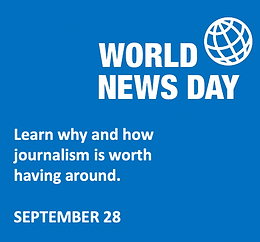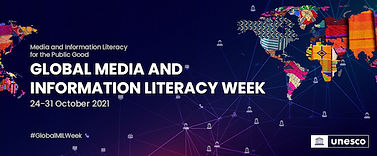

WHY journalism
SOME BASIC BACKGROUND RESOURCES
Taking a journalistic approach to dissecting all content can be very powerful. Before starting to do that, it's useful to know what real journalism at its best is supposed to be.
This first part of the collection aims to examine basics of good journalism via a particularly accessible examination of one case with global implications plus two examples of news organizations that combined journalism with advocacy campaigns around a cause embraced by young people all over the planet: protection of the environment. The next parts will look at how to reach journalists for real testimony and how to provide an experience in doing journalism.
These resources work best with people at least in their teens.
_poster.jpg)
FIRST, WATCH A MOVIE
[For teenagers and older]
The 2-hour contemporary film Spotlight describes how The Boston Globe, a U.S. newspaper, revealed the cases of dozens of priests who got away with sexually abusing teenagers and children for decades with the complicity of the Catholic church.
The 2017 film describes actions from 2002 in a way that continues to have relevance because the issue still resonates globally and the film offers a solid overview of journalistic excellence.
Allan Miller, CEO of the News Literacy Project, gives a good explanation of why why it's useful in explaining how journalism is important anywhere:
"[Spotlight brings] attention to journalism’s watchdog role — holding the powerful accountable — and the importance of a local newspaper to its community at a time when journalism was increasingly under fire and many local publications were failing. It portrayed the reporters and editors as heroic, though fallible, and reflected the essential role of principled sources and courageous victims to bring vital, if excruciatingly painful, truths to light."
SPOTLIGHT
[02:09:00]
Available through many streaming services, including YouTube, iTunes, Google Play Movies, Amazon and Netflix.
The movie, which takes very few liberties with the real story, also provides compellilng, quality entertainment and won film awards in Canada, Italy, the United Kingdom and the United States.
The issue remains relevant with similar cases reported recently elsewhere in the United States and all over the world.
MORE ABOUT THE CASE:
THE REAL REPORTERS, the FULL STORY
The links below connect to interviews with the real reporters who did the coverage, offering further insights into the realities and challenges in investigating such a difficult issue, and to a very good set of activities from the Journalism Education Association (USA).
BRIEF Interview with MEMBErS
OF THE real Spotlight team
[VIDEO 00:04:56, ABC News]
How the REAL Spotlight team works
[VIDEO 00:12:17, Boston Globe]
The FULL story of the reporting
[VIDEO 00:59:10, C-span]
ActivitIES
(PDF) Journalism Education Association (USA)
SECOND, EXPLORE SOLUTIONS AND ADVOCACY:
When good journalism does more
than REPORT ABOUT THE PROBLEM
Good journalists argue regularly about the extent to which their role should stop — or not — at describing what is going on to look for solutions or even promote change.
Advocacy by individual reporters within a news organization has remained a highly controversial practice for centuries, with no end in sight to the discussion. It is often prohibited by national and international ethical codes and yet not infrequently embraced by even highly respected journalists.
Here are some recent explorations of the topic of individual and institutional advocacy.
For the International Center for Journalists, Sherry Riccardi explores one African case of a reporter giving financial support to a source in need (2020).
In 2020, the Center for Media, Data and Society at Hungary's Central European University looked at four cases of media-advocacy partnerships in Africa and Latin America
On the topic of climate, there is a more frequent willingness than for other kinds of stories for their news organization to go beyond providing basic reporting of the problem to also look at solutions and even push for change.
The Solutions Journalism network’s Project Drawdown uses journalism to help find the answers that will help the planet move as quickly and safely as possible to drawdown "the point in the future when levels of greenhouse gases in the atmosphere stop climbing and start to steadily decline, thereby stopping catastrophic climate change." Its database contains dozens of such stories related to climate.
Here are two cases in which news media companies in India and Poland worked with young people in successful campaigns to fix an environmental problem.

CASE 1
Clearing the air for India's worst-polluted city
In 2018, India's Dainik Jagran used a combination of reporting and an accompanying campaign that included students to persuade the authorities in the suffocating city of Lucknow, the city with the world's fourth worst air quality, to take action that significantly reduced air pollution. It worked.

CASE 2
SAVING Poland's ROSPUDA RIVER
FROM A CONCRETe GRAVE
Poland's Gazeta Wyborcza conducted a youth-oriented campaign that helped stop highway construction in the Rospuda Valley, a rich bio-diverse river area of Poland.
Grzegorz Piechota, researcher-in-residence at the International News Media Association and a former research fellow at Harvard and Oxford universities, was the project manager for that 2007 campaign and explains why it's still relevant:
-
Protection of the natural environment is a moral duty of humanity and requires bold leadership as the globe faces a climate crisis.
-
The key conflict of values — a duty to protect natural resources versus a desire to modernize the infrastructure and grow economy — is common across the world and especially difficult to negotiate in developing countries.
-
Young audiences recognize the importance of the subject and engage with it, and the popularity of Greta Thunberg is one the examples.
-
The Gazeta case also exemplifies the importance of youth and young adults’ engagement in decision making in democracies (the young are political), the value of public dialogue (e.g., the right of the international and national communities to engage in a local issue due to the public interest), etc.
-
From the journalism perspective, this case inspires a discussion whether journalists can express their views and whether there are or should be the boundaries between engaged journalism and activism.
-
From the marketing perspective, this case shows that the medium should be customer-centric rather than a product-centric in the sense that it needs to reach the target audience in the channels and formats that audience uses to be successful.
SOME ACTIVITIES
Facing History and Ourselves, the U.S. provides extensive activity materials linked to the still-riveting 2009 documentary, Reporter (available on streaming services), which followed New York Times journalist Nicholas Kristof in the Democratic Republic of the Congo as he worked on stories to bring attention to the humanitarian plight there.
The Solutions Journalism network provides some examples of activities linked to stories using that approach and offers a free newsletter with teaching advice twice a month.


